
- •Wave energy
- •Mechanical waves in elastic medium
- •8.1. Harmonic Vibrations and Their Characteristics
- •Figure 8.1
- •8.2. Differential Equation for Own (Free) Harmonic Vibrations
- •8.3. Energy of Harmonic Vibrations
- •8.4. Damped Vibrations
- •8.5. Addition of Harmonic Vibrations with Equal
- •Figure 8.8
- •8.6. Addition of Perpendicular Vibrations
- •Figure 8.9
- •8.7. Representation of Vibrations with the Help of Fourier Series
- •8.8. Waves. Equation of Mechanical Harmonic Wave
- •Figure 8.16
- •Characteristics of a harmonic wave
- •8.9. Differential Wave Equation
- •8.10. Mechanical Waves in Elastic Medium.
- •8.11. Energy of Elastic Waves
- •8.12. Wave Superposition and Interference
- •8.13. Dispersion of Waves.
- •8.14. Sound
- •8.15. The Doppler Effect in Acoustics
- •Figure 8.24
- •Text 3.1 Electromagnetic Induction. Electromagnetic Waves.
- •Home task
- •Electric charge and field coulomb’s law
- •1.1. Introduction
- •1.2. Electric Charge
- •1.3. Electrostatic Phenomena
- •1.4. Coulomb’s Law
- •6.2 Automation in industry
- •6.4.Changes in matter
- •Vocabulary:
- •Intensity of electric field
- •2.1. Electric Field as Form of Matter
- •2.2. The Tensity of Electric Field
- •2.3. Graphic Representation of Electric Fields
- •2.5. The Superposition Principle
- •Text 9.1.: introduction to the www and the internet
- •The internet
- •5. Dynamics of material points system. Conservation of energy
- •5.1. Work
- •Figure 5.1
- •Figure 5.2
- •Figure 5.3
- •5.2. Power
- •5.3. Energy
- •5.4. Kinetic Energy
- •Figure 5.3
- •Therefore
- •5.5. Potential Energy
- •5.6. Total Energy of System. Conservation of Energy
- •5.7. Perfectly Elastic Collisions
- •5.8. Completely Inelastic Collisions
- •Famous people of science and engineering
- •I. The main features and peculiarities
- •II. The structure of the simple sentence
- •III. The compound sentence and the complex sentence
- •IV. Attributive groups of nouns
- •V. The system of the english tenses in the active voice
- •VI. The group of perfect and perfect continuous tenses
- •VII. The system of the english tenses in the passive voice
- •IX. The participle and its functions the participial constructions
- •X. The gerund and its functions the complexes with the gerund
- •XI. Modal verbs
- •XII. The subjunctive mood
- •Vocabulary.
8.5. Addition of Harmonic Vibrations with Equal
Frequencies and One Direction
An arbitrary vibration system can simultaneously execute several vibrations. Several vibrations in this case add and give the resultant vibration. Addition of vibrations is carried out on the basis of the principle of superposition:
when a subject takes part in several vibrations these vibrations add independently without influencing each other.
Usually under the addition of vibrations it is understood a determination of the law for resultant vibrations of a system participating in several vibration processes.
V e c t o r r e p r e s e n t a t i o n o f v i b r a t i o n
Let us consider the vector A rotating about the point O (Fig. 3.7) with the uniform velocity . Let 0 be the angle between the vector A and the vertical line at the moment t = 0. The projection of the vector A on the axis x at t = 0 is given by:
x = Asin0.
At an arbitrary moment of the time t the angle between the vector A and the vertical line is = (0 + t) and the projection of the vector A on the axis x is given by:
x = Asin(t + 0).
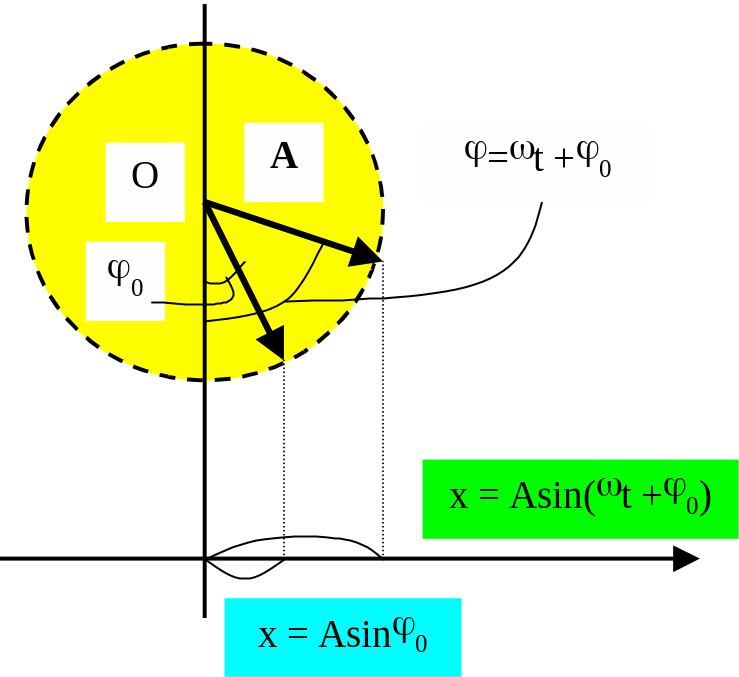
Figure 8.6.
The harmonic vibration can be represented as the projection of the vector A, which rotates about the point O with the uniform velocity .
M o d e l s y s t e m t o s t u d y v i b r a t i o n s a d d i t i o n
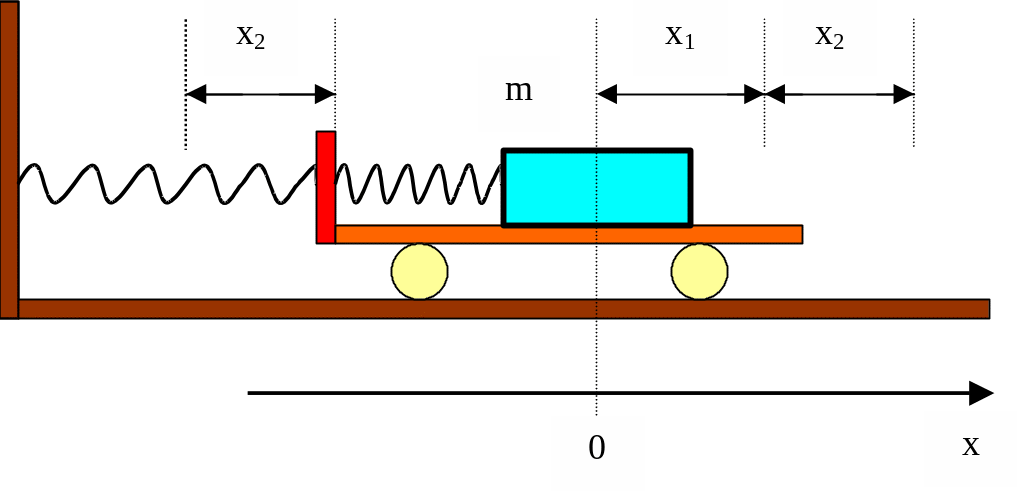
Figure 8.7
The body with the mass m (Fig.8.7) participates in two vibrations and at an arbitrary moment of time the resultant displacement equals to:
x = x1 + x2,
where
x1 = A1sin1 = A1sin(1t + 01),
x2 = A2sin2 = A2sin(2t + 02).
Let us consider the addition of coherent vibrations.

Figure 8.8
Two vibrations x1 and x2 are called coherent vibrations if difference of their phases does not depend on time:
![]()
From the expression
![]()
we can find that the difference of phases does not depend on time in the case when 1 = 2.
For the sum of vibrations the vector A(t) corresponds (Fig. 3.9):
A(t) = A1(t) + A2(t).
Then (when 1 = 2 = ):
x = x1 + x2 = A1sin(t + 01) + A2sin(t + 02) = Asin(t + 0).
Using the theorem of cosines we can obtain (Fig. 3.9):
A2 = A12 + A22 + 2A1A2cos(01 - 02),
![]()
The addition of two harmonic coherent vibrations of one direction gives the harmonic vibration with the same frequency and its amplitude depends on the amplitudes and initial phases of separate vibrations.
8.6. Addition of Perpendicular Vibrations
T he
model system for consideration of perpendicular vibrations is shown
in Fig.8.9.
he
model system for consideration of perpendicular vibrations is shown
in Fig.8.9.
Figure 8.9
Laws of vibrations with perpendicular directions are:
x = A1sin1 = A1sin(t + 01),
y = A2sin2 = A2sin(t + 02).
At arbitrary moment of time the body is located at the distance r from the origin of Cartesian framework:
![]()
Providing simple transformations of the following expressions it is easy to obtain the general law of the body motion in this case:


After mentioned operations the general equation of ellipse was evaluated:
![]()
Note that (01 - 02) = (1 - 2).
The analysis of resultant equation.
1). If (1 - 2) = /2, then
![]()
and the trajectory of the resultant motion is given in Fig. 8.10.
F igure
8.10
igure
8.10
2). If (1 - 2) = 0, then
![]()
![]()
a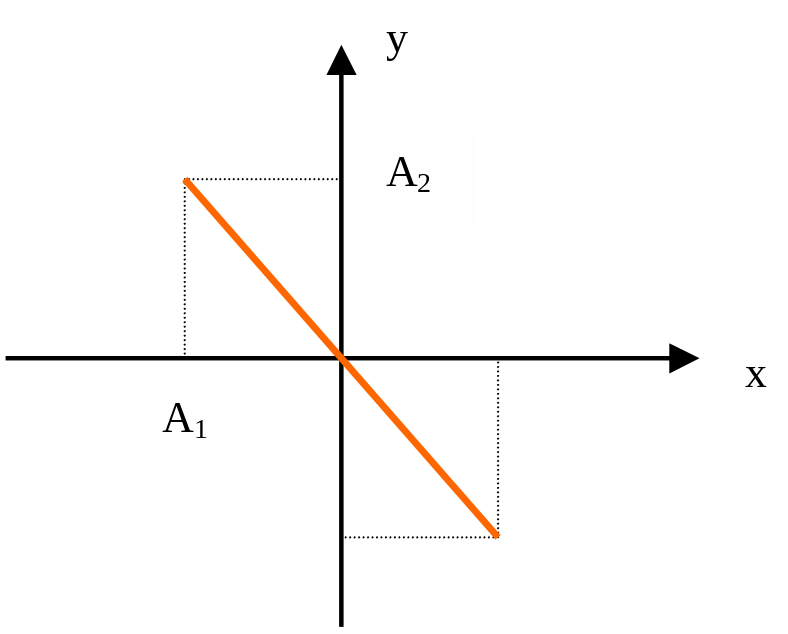 nd
the trajectory of the resultant motion is given in Fig. 8.11.
nd
the trajectory of the resultant motion is given in Fig. 8.11.
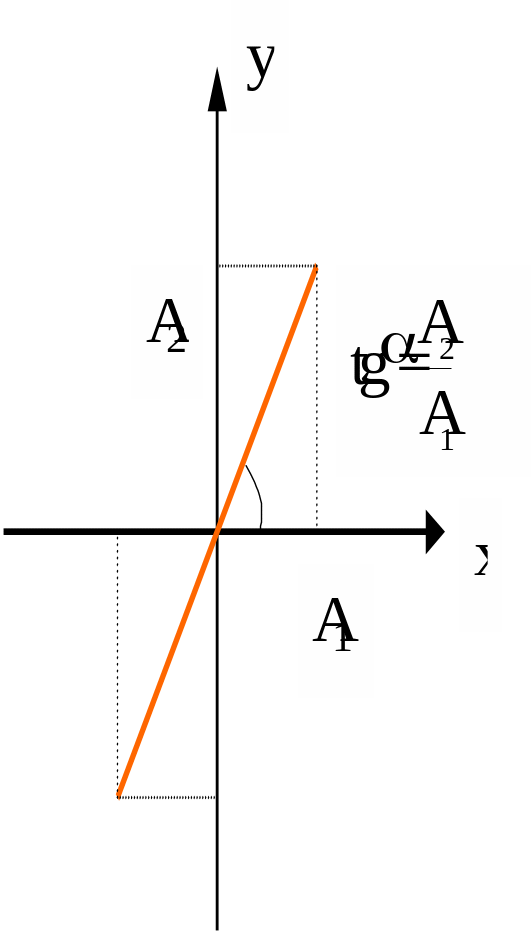 Figure 8.11
Figure 8.12
Figure 8.11
Figure 8.12
3). If (1 - 2) = , then
![]()
![]()
and the trajectory of the resultant motion is given in Fig. 8.12.
A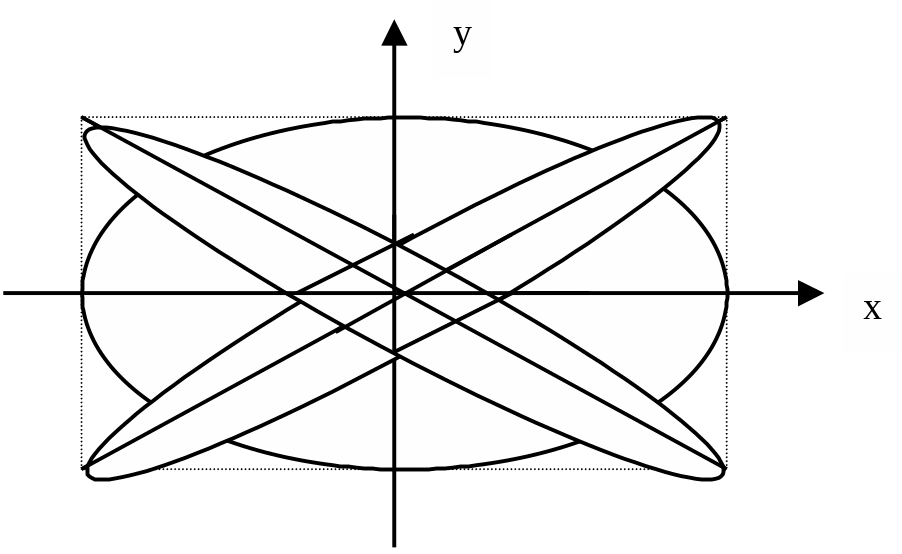 s
a result of the addition of two coherent perpendicular vibrations we
obtain the movement around the ellipse. Only for the cases when (1
- 2) equals to 0 or
we obtain vibrations again, but their direction differs from the
directions of the added vibrations (Fig. 8.13).
s
a result of the addition of two coherent perpendicular vibrations we
obtain the movement around the ellipse. Only for the cases when (1
- 2) equals to 0 or
we obtain vibrations again, but their direction differs from the
directions of the added vibrations (Fig. 8.13).
Figure 8.13
